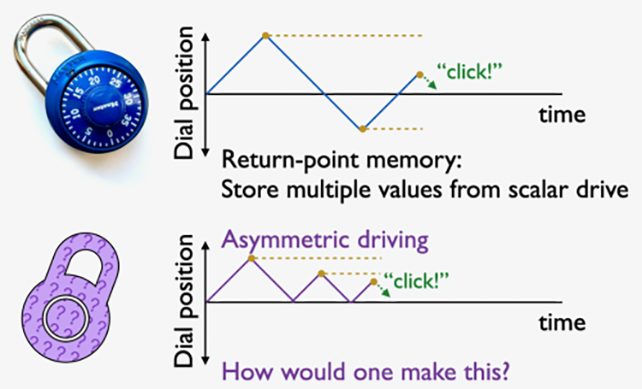Scientists have found a new way that materials can form 'memories' about what's happened to them in the past, potentially opening up new and exciting possibilities across computing and mechanical engineering.
The idea of memory in materials isn't new – a wrinkled piece of paper shows the memory of its former crumpled state, for example – but here researchers at the University of Chicago and Pennsylvania State University were able to build on what's known as return-point memory, which relies on back-and-forth force in two directions.
Return–point memory is a bit like a combination lock spinning one way and then the other, but the researchers found that force in one direction could still be used to store memories in specific circumstances.

"The mathematical theorems for return-point memory say that we can't store a sequence if we only have this asymmetrical driving in one direction," says physicist Nathan Keim, from Pennsylvania State University.
"If the combination lock dial can't go past zero when turning counterclockwise, it only stores one number in the combination. But we found a special case when this kind of asymmetrical driving can, in fact, encode a sequence."
Using computer models to simulate different force directions and strengths, the researchers came up with abstract elements called hysterons. Crucially, these hysterons could experience "frustrated interactions" that break the rules of return-point memory.
"Hysterons are elements of a system that may not immediately respond to external conditions, and can stay in a past state," says physicist Travis Jalowiec, from Pennsylvania State University. "Like how parts of a combination lock reflect the previous positions of the dial, and not where the dial is now."
Pulling on a bendy straw is one way to picture it: while the movement is in one direction, the popping open of one fold in the straw neck but not the others relieves tension in the whole system. Assessing all the folds offers clues about the past forces that have been applied.
It's not a perfect analogy, but it gives you a general idea. The researchers found that frustrated hysterons could act as memory banks for the most recent deformation and the largest deformation to date.
"If you can make a system that stores a sequence of memories, you can use it like a combination lock to verify a specific history, or you could recover diagnostic or forensic information about the past," says Keim.
While frustrated hysterons are likely to be rare in real materials, the researchers say, they could be built into artificial materials – a new type of material memory to work with. Eventually, we could have mechanical systems that remember past states without requiring any electricity.
"We think this is a way to design artificial systems with this special kind of memory, starting with the simplest mechanical systems not much more complicated than a bendy straw and hopefully working up to something like an asymmetrical combination lock," says Keim.
The research has been published in Science Advances.
